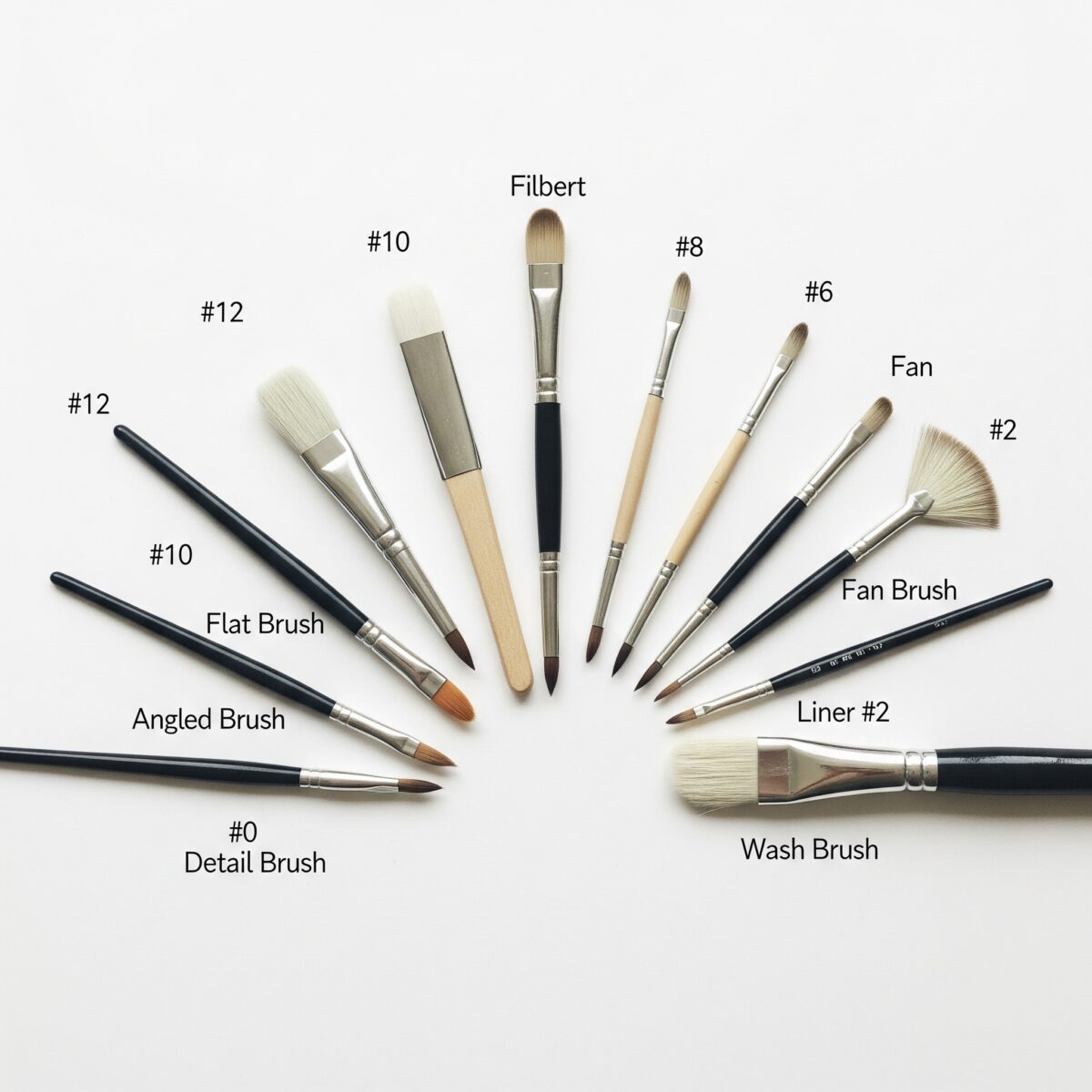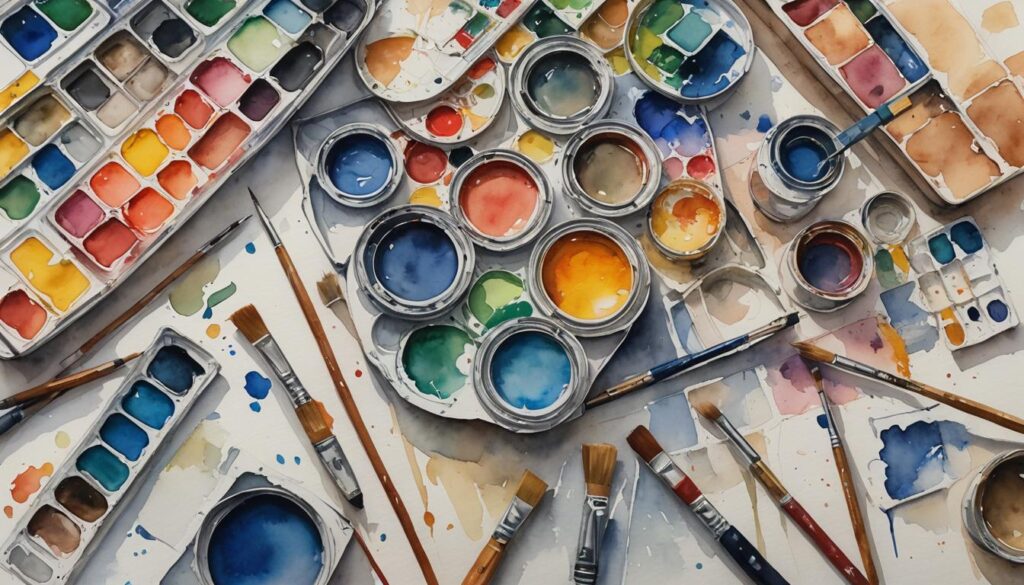Choosing the right types of paint brushes and their uses can make or break your artwork. Whether you’re just starting your artistic journey or looking to expand your brush collection, understanding which brush works best for different techniques will transform how you paint. From delicate watercolor washes to bold acrylic strokes, each brush type serves a specific purpose that can elevate your art to the next level.
Key Points Summary
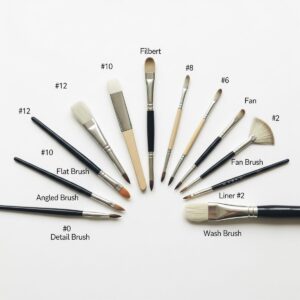
- Round brushes excel at details, lines, and controlled paint application
- Flat brushes create bold strokes, sharp edges, and cover large areas quickly
- Specialty brushes (filbert, fan, angular) offer unique texturing and blending capabilities
- Natural bristles work best with oil paints, while synthetic brushes suit acrylics and watercolors
- Proper brush care extends brush life and maintains painting quality
- Size numbers indicate brush width, with higher numbers meaning larger brushes
Understanding Basic Brush Anatomy
Before diving into specific brush types, let’s understand what makes a brush work. Every paint brush has three main parts: the bristles (or brush head), the ferrule (metal band), and the handle. The bristles determine how paint flows and what marks you can make. The ferrule holds everything together and affects brush durability. The handle length influences your grip and control.
Think of brushes like different tools in a toolbox – each one designed for specific jobs. Just as you wouldn’t use a hammer to turn a screws, you wouldn’t use a large flat brush for tiny details.
Types of Paint Brushes and Their Uses: The Essential Guide
Round Brushes: The Versatile Workhorses
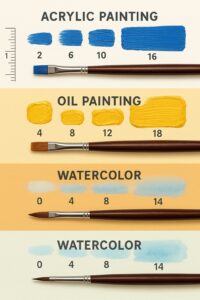
Round brushes are probably the most versatile tools in any artist’s collection. Their pointed tips make them perfect for:
- Detail work and fine lines: Creating hair strands, tree branches, or intricate patterns
- Dot and stippling techniques: Building texture through repeated dots
- Color mixing: Blending colors directly on canvas
- Outlining and sketching: Initial drawing and composition work
Round brushes come in sizes from 000 (tiny) to 24 (large). A size 2 round brush works great for details, while a size 12 handles broader areas. The best paint brushes for beginners typically include several round brush sizes.
Flat Brushes: Bold and Efficient
Flat brushes have straight, square-cut bristles that create distinctive marks. They’re your go-to choice for:
- Bold, confident strokes: Creating strong horizontal and vertical lines
- Filling large areas: Backgrounds, skies, and broad color blocks
- Sharp, clean edges: Architectural elements and geometric shapes
- Color blocking: Applying solid areas of color efficiently
The width of flat brushes ranges from tiny 1/8-inch brushes to massive 4-inch brushes. A 1/2-inch flat brush handles most general painting tasks beautifully.
“Flat brushes are like painting with confidence – they force you to make bold decisions and commit to your strokes.”
Professional Artist Maria Rodriguez
Filbert Brushes: The Perfect Compromise
Filbert brushes combine the best features of round and flat brushes. Their oval, rounded tips offer:
- Smooth blending: Perfect for soft color transitions
- Natural-looking strokes: Mimicking organic shapes and forms
- Versatile mark-making: Both precise and broad applications
- Ideal for portraits: Capturing skin tones and facial features
Filberts work exceptionally well for acrylic painting techniques where you need both control and coverage.
Specialty Brushes for Unique Effects
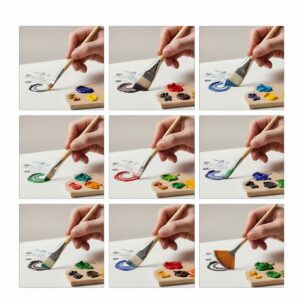
Angular Brushes: Precision Tools
Angular (or angled) brushes have bristles cut at a diagonal, creating a wedge shape. They excel at:
- Precise corners and edges: Perfect for architectural details
- Controlled lines: Creating consistent width strokes
- Tight spaces: Painting around objects or in confined areas
- Lettering and calligraphy: Consistent line weights
Fan Brushes: Texture Masters
Fan brushes spread their bristles in a fan shape, making them ideal for:
- Natural textures: Tree foliage, grass, and clouds
- Blending and softening: Creating smooth color gradations
- Special effects: Splatter techniques and stippling
- Hair and fur: Realistic animal and portrait details
Liner Brushes: Fine Detail Champions
Liner brushes (also called rigger or script brushes) have long, thin bristles perfect for:
- Ultra-fine lines: Detailed linework and intricate patterns
- Calligraphy and lettering: Consistent, flowing strokes
- Outlining: Clean, precise edges around shapes
- Signature work: Adding your name to finished pieces
Natural vs Synthetic Brush Materials
Natural Bristle Brushes
Natural brushes use animal hair like hog bristle, sable, or squirrel hair. Each type offers different qualities:
| Hair Type | Best For | Characteristics |
|---|---|---|
| Hog Bristle | Oil painting | Stiff, holds lots of paint, durable |
| Red Sable | Watercolor, details | Soft, excellent point, expensive |
| Squirrel Hair | Watercolor washes | Very soft, holds water well |

Natural brushes work best with oil paints because the bristles’ texture helps move thicker paint effectively.
Synthetic Brush Materials
Synthetic brushes use manufactured fibers like nylon or polyester. They offer:
- Consistent performance: Every brush behaves predictably
- Easy cleaning: Less likely to hold paint or stain
- Durability: Last longer with proper care
- Affordability: Generally less expensive than natural options
Synthetic brushes excel with acrylic paints and watercolors. They’re also essential painting supplies for artists concerned about animal welfare.
Choosing Brushes by Paint Medium
Acrylic Paint Brushes
Acrylic paints dry quickly and can be harsh on natural bristles. For acrylics, choose:
- Synthetic brushes: They resist the paint’s alkaline nature
- Medium to stiff bristles: Handle acrylic’s thick consistency
- Flat and filbert shapes: Most versatile for acrylic techniques
Watch this helpful video on acrylic brush selection:
Oil Painting Brushes
Oil paints stay wet longer and have different flow characteristics. Best choices include:
- Natural bristle brushes: Hog bristle for general work, sable for details
- Stiff to medium flexibility: Move thick paint effectively
- Round and flat shapes: Traditional choices for oil techniques
Learn more about oil painting brush techniques from professional resources.
Watercolor Brushes
Watercolor requires brushes that hold water well and maintain their points:
- Natural hair preferred: Sable or squirrel for best results
- Soft, flexible bristles: Allow smooth water flow
- Round shapes primarily: Essential for watercolor control
For comprehensive watercolor guidance, check out watercolor painting fundamentals.
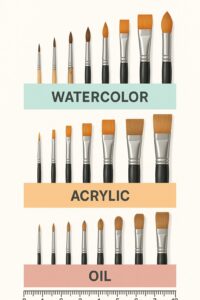
Paint Brush Sizes Explained
Brush size numbers can seem confusing, but they follow a simple system:
- Smaller numbers = Smaller brushes (000, 00, 0, 1, 2…)
- Larger numbers = Larger brushes (…10, 12, 16, 20, 24)
- Different shapes may have slightly different actual sizes for the same number
Recommended Starter Sizes
For beginners, these sizes cover most painting needs:
- Round brushes: Sizes 2, 6, and 12
- Flat brushes: Sizes 4, 8, and 16
- Detail brush: Size 0 or 00
- Wash brush: Size 1-2 inches wide
Brush Care and Maintenance
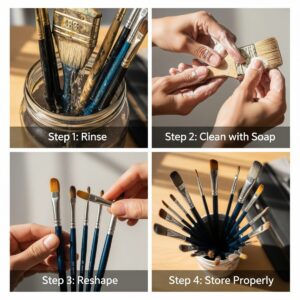
Proper brush care extends brush life significantly and maintains painting quality. Here’s your essential maintenance routine:
Immediate Cleaning
- Rinse thoroughly: Remove paint immediately after use
- Use appropriate solvents: Water for acrylics/watercolors, turpentine for oils
- Gentle soap washing: Baby shampoo works excellently
- Reshape while damp: Reform the brush tip to its original shape
Proper Storage
- Store bristles up: Prevents damage and maintains shape
- Use brush holders: Protect tips from bending
- Avoid leaving in water: Causes ferrule damage and bristle splaying
For detailed cleaning instructions, see our guide on how to clean oil paint brushes naturally.
Professional vs Budget Brushes
When to Invest in Quality
Professional brushes justify their cost through:
- Superior materials: Better bristles and construction
- Longer lifespan: Quality brushes last years with proper care
- Better performance: More predictable paint handling
- Consistent results: Reliable brush behavior
Budget-Friendly Options
For beginners or casual painters:
- Synthetic brush sets: Affordable and reliable
- Mixed sets: Combine different shapes and sizes economically
- Student-grade brands: Adequate quality at lower prices
The Princeton Art Brush Company offers excellent mid-range options that balance quality and affordability.
Advanced Brush Techniques
Once you master basic brush types, experiment with these advanced techniques:
Dry Brushing
Use minimal paint on your brush to create textured, broken color effects. Perfect for weathered surfaces, bark texture, or fabric details.
Wet-on-Wet
Apply wet paint over still-wet paint to create soft, blended effects. Essential for cloud painting and smooth color transitions.
Scumbling
Lightly drag a dry brush loaded with opaque paint over previous layers to create broken color effects and visual texture.
Building Your Brush Collection
Start with essential types of paint brushes and their uses, then expand based on your artistic interests:
Essential Starter Set (6-8 brushes)
- Round brushes: sizes 2, 6, 12
- Flat brushes: sizes 4, 10
- Detail brush: size 0
- Wash brush: 1-inch flat
- Filbert brush: size 8
Intermediate Expansion (10-15 additional brushes)
- Specialty shapes: fan, angular, liner
- Size variations: very small and very large options
- Medium-specific brushes: separate sets for oils and acrylics
For complete guidance on building your collection, explore our comprehensive painting supplies guide.
Brush Buddy
Find the perfect brush size and shape for your medium
Choose Your Medium
Recommended Brush Shapes
Recommended Brush Sizes
Brush Tips
- Always clean brushes thoroughly after use to maintain their shape.
- For oil paints, use odorless mineral spirits for cleaning.
- Soak watercolor brushes before use to avoid damaging bristles.
- Store brushes upright or flat — never resting on the tip.
- Replace worn brushes to ensure better control and quality results.
Frequently Asked Questions
What are the different types of paint brushes called? The main brush types are round (pointed tip), flat (square cut), filbert (oval shaped), angular (diagonal cut), fan (spread bristles), liner (long thin bristles), and wash brushes (large and wide).
What is each paint brush used for? Round brushes handle details and lines, flat brushes create bold strokes and fill areas, filberts blend colors smoothly, angular brushes paint precise edges, fan brushes create textures, and liner brushes make fine lines.
How do I choose the right paint brush? Consider your paint medium, desired technique, and detail level needed. Synthetic brushes suit acrylics, natural bristles work well with oils, and soft brushes are best for watercolors.
What’s the difference between natural and synthetic brushes? Natural brushes use animal hair (hog, sable, squirrel) and often hold more paint with better texture. Synthetic brushes use manufactured fibers, are more durable, easier to clean, and work excellently with water-based paints.
Which brushes are best for beginners? Start with synthetic brushes in basic shapes: round brushes (sizes 2, 6, 12), flat brushes (sizes 4, 10), one detail brush (size 0), and a wash brush. This covers most painting needs affordably.
What does the number on a paint brush mean? Brush numbers indicate size – smaller numbers mean smaller brushes. A size 2 brush is much smaller than a size 12. The actual width varies slightly between manufacturers and brush shapes.
Understanding types of paint brushes and their uses transforms your painting experience from frustrating to fulfilling. Each brush type serves specific purposes, and building your knowledge helps you make confident choices in your art supply purchases. Remember that great brushes don’t make great artists – practice does. Start with quality basics, maintain them properly, and gradually expand your collection as your skills and interests develop. Whether you’re painting landscapes, portraits, or abstract works, the right brush makes every stroke count toward creating the art you envision.

